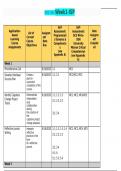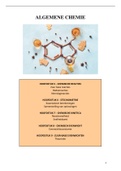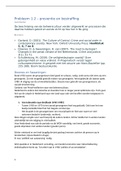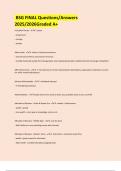CPLD Level 2
Unit 1
Patterns of child development
Learning Aim, A- Understand growth and development in children
Learning Aim B- Understand the characteristics of children’s development from birth up to
eight years
Learning Aim C- Understand how adults in early years settings can support children’s
development
,Growth and development
Growth
‘Haven’t you grown?’ This is what most adults say when they have not seen a child for
a while. Growth is a major feature of childhood. Growth takes place because certain
cells in the body keep dividing. This division of cells means that during childhood
children increase in height and weight. Their bones become longer and so their
skeleton changes. Growth also affects the development of muscles. Interestingly,
during childhood the brain also grows.
How growth is measured
From birth onwards children are frequently measured by health visitors. Their height,
weight and also head circumference are measured. The results are marked on a chart
called a centile chart. The results form a graph which shows how much the child has
grown and whether the growth is even. The centile chart also has bands on it showing
where the child’s growth is compared to children of the same age. Health professionals
will often take time to look at children who are not growing as expected. This can
sometimes be a sign of medical problems or it might be a sign that the child is not
eating the right quantity or type of food.
Factors affecting growth
There are a wide range of factors that affect a child’s growth.
Factor How it affects children’s growth
Heredity Children’s genetic make-up that
they inherit from their biological
parents will affect children’s
overall height. Some medical
conditions affecting growth can
also be inherited.
Hormones Hormones are chemicals. They
act as ‘messengers’ and tell
cells when to divide. At certain
stages in children’s lives an
increase in hormones will
produce more rapid growth. A
good example of this in young
people is during puberty.
Nutrition The body needs energy in order
to grow. The body also needs a
wide range of substances called
nutrients in order for muscles,
bones and organs to keep
2
, healthy, and also to grow.
Children who are not eating a
balanced diet may have uneven
or insufficient growth.
Sleep Sleep is important for growth.
During sleep, hormones for
growth are produced. Babies
usually sleep between 12 and
14 hours a day, while young
children will need at least 10 to
12 hours. Children who do not
sleep well may have uneven
growth.
Illness Children who are frequently ill
may not grow well. This is
because they may not feel like
eating or they may not be
sleeping well. Some types of
diseases can also make it hard
for the digestion of nutrients to
take place.
Emotional Influences There are many reasons why
children may not be relaxed and
happy. This includes separation
of parents, the death or a close
relative or not being settled in
an early years setting. When
children have long periods of
unhappiness, they are less
likely to sleep or eat well. They
are also more likely to become
ill.
Development
The term ‘development’ is used to talk about the skills and knowledge that children
gain. Over time, they gain skills and knowledge, such as being able to walk, draw a
picture or count.
Holistic development
While all children develop, some will do so more quickly than others. Interestingly,
children rarely acquire skills and knowledge evenly. A good example of this is a child
aged 3 who might be able to name three colours but cannot yet kick a ball. When early
years practitioners and health visitors look at children’s development, they tend to look
at the whole picture of what a child can do. The term to describe this approach is
holistic development.
3
, Norms of development
When a baby starts to crawl, or when a child can say their name, these are special
moments in their development. These are called milestones. For every age group,
there is a list of milestones that most children will meet. These are the developmental
norms. An example of a developmental norm is that by the age of 2, most children will
say 50 or so words. Decisions about what to expect are based on looking at what most
children do at a particular age. Looking at children’s progress is usually done using the
milestones for their age. Knowing about the milestones for each child can help you
plan activities, but also help to spot any children who may need more support.
Five key areas of development
As there are so many aspects involved in children’s development, it is normally split
into five broad areas. These development areas include, physical development,
cognitive development, communication and language development, social
development, and emotional and behavioural development.
Physical development
This is about the way that children move and use their bodies. It is divided
further into gross motor movements and fine motor movements.
Gross motor movements involve use of the arms and legs. Kicking and throwing
would be examples of gross motor movements. As part of gross motor
movements, children also learn to be mobile. These movements are called
locomotive movements. They involve balance and coordination.
Fine motor movements are usually about the hands. There are many skills
involved in fine motor movements. These include hand-eye coordination. This is
where the hands and eyes work together, for example, in handwriting and
sewing. Children’s hands also have to develop strength and a range of
movements called fine manipulative movements. These are quite complex or
intricate. Being able to turn the lid of a bottle is an example of this; so too is the
tripod grasp, sometimes known as the pencil grasp.
4
Unit 1
Patterns of child development
Learning Aim, A- Understand growth and development in children
Learning Aim B- Understand the characteristics of children’s development from birth up to
eight years
Learning Aim C- Understand how adults in early years settings can support children’s
development
,Growth and development
Growth
‘Haven’t you grown?’ This is what most adults say when they have not seen a child for
a while. Growth is a major feature of childhood. Growth takes place because certain
cells in the body keep dividing. This division of cells means that during childhood
children increase in height and weight. Their bones become longer and so their
skeleton changes. Growth also affects the development of muscles. Interestingly,
during childhood the brain also grows.
How growth is measured
From birth onwards children are frequently measured by health visitors. Their height,
weight and also head circumference are measured. The results are marked on a chart
called a centile chart. The results form a graph which shows how much the child has
grown and whether the growth is even. The centile chart also has bands on it showing
where the child’s growth is compared to children of the same age. Health professionals
will often take time to look at children who are not growing as expected. This can
sometimes be a sign of medical problems or it might be a sign that the child is not
eating the right quantity or type of food.
Factors affecting growth
There are a wide range of factors that affect a child’s growth.
Factor How it affects children’s growth
Heredity Children’s genetic make-up that
they inherit from their biological
parents will affect children’s
overall height. Some medical
conditions affecting growth can
also be inherited.
Hormones Hormones are chemicals. They
act as ‘messengers’ and tell
cells when to divide. At certain
stages in children’s lives an
increase in hormones will
produce more rapid growth. A
good example of this in young
people is during puberty.
Nutrition The body needs energy in order
to grow. The body also needs a
wide range of substances called
nutrients in order for muscles,
bones and organs to keep
2
, healthy, and also to grow.
Children who are not eating a
balanced diet may have uneven
or insufficient growth.
Sleep Sleep is important for growth.
During sleep, hormones for
growth are produced. Babies
usually sleep between 12 and
14 hours a day, while young
children will need at least 10 to
12 hours. Children who do not
sleep well may have uneven
growth.
Illness Children who are frequently ill
may not grow well. This is
because they may not feel like
eating or they may not be
sleeping well. Some types of
diseases can also make it hard
for the digestion of nutrients to
take place.
Emotional Influences There are many reasons why
children may not be relaxed and
happy. This includes separation
of parents, the death or a close
relative or not being settled in
an early years setting. When
children have long periods of
unhappiness, they are less
likely to sleep or eat well. They
are also more likely to become
ill.
Development
The term ‘development’ is used to talk about the skills and knowledge that children
gain. Over time, they gain skills and knowledge, such as being able to walk, draw a
picture or count.
Holistic development
While all children develop, some will do so more quickly than others. Interestingly,
children rarely acquire skills and knowledge evenly. A good example of this is a child
aged 3 who might be able to name three colours but cannot yet kick a ball. When early
years practitioners and health visitors look at children’s development, they tend to look
at the whole picture of what a child can do. The term to describe this approach is
holistic development.
3
, Norms of development
When a baby starts to crawl, or when a child can say their name, these are special
moments in their development. These are called milestones. For every age group,
there is a list of milestones that most children will meet. These are the developmental
norms. An example of a developmental norm is that by the age of 2, most children will
say 50 or so words. Decisions about what to expect are based on looking at what most
children do at a particular age. Looking at children’s progress is usually done using the
milestones for their age. Knowing about the milestones for each child can help you
plan activities, but also help to spot any children who may need more support.
Five key areas of development
As there are so many aspects involved in children’s development, it is normally split
into five broad areas. These development areas include, physical development,
cognitive development, communication and language development, social
development, and emotional and behavioural development.
Physical development
This is about the way that children move and use their bodies. It is divided
further into gross motor movements and fine motor movements.
Gross motor movements involve use of the arms and legs. Kicking and throwing
would be examples of gross motor movements. As part of gross motor
movements, children also learn to be mobile. These movements are called
locomotive movements. They involve balance and coordination.
Fine motor movements are usually about the hands. There are many skills
involved in fine motor movements. These include hand-eye coordination. This is
where the hands and eyes work together, for example, in handwriting and
sewing. Children’s hands also have to develop strength and a range of
movements called fine manipulative movements. These are quite complex or
intricate. Being able to turn the lid of a bottle is an example of this; so too is the
tripod grasp, sometimes known as the pencil grasp.
4











